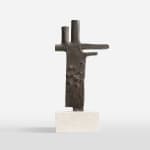Julio González
Further images
Main aux piquants (Hand with Spikes) by Julio González is a masterful exploration of form and symbolism, blending the organic shape of the hand with jagged, defensive elements that suggest a readiness for confrontation. This sculpture, cast in bronze with iron nails, stands as a precursor to González’s later works like Homme Cactus (1939), where the human body is depicted as both vulnerable and armed. In Main aux piquants, the hand is no longer just a tool for creation but a shield and weapon, a representation of survival amidst harsh realities.
The visual qualities of this sculpture are striking. The juxtaposition of smooth bronze with the sharp protrusions of iron nails creates a dialogue between softness and aggression, vulnerability and protection. The verticality of the piece, paired with its defensive spikes, hints at a human figure poised to defend itself—a posture that communicates both readiness and defiance. The tactile quality of the materials, combined with González’s precise craftsmanship, invites viewers to reflect on the dual nature of the human experience: the desire to connect and the instinct to protect.
González’s sculpture’s geometric forms and pared-down anatomy demonstrate his familiarity with both Cubism and tribal art. Main aux piquants recalls the Nkisi Nkondi power figures of the Kongo peoples of central Africa—wooden sculptures into which hundreds of nails and metal implements were often hammered. These figures were believed to embody spiritual energy and act as protectors, and González’s use of iron spikes in his work mirrors this powerful symbolism. By drawing on these visual traditions, González not only bridges the gap between European modernism and African art but also imbues his work with layers of meaning that speak to the universality of resistance and spiritual force.
This piece, like many of González’s works from the late 1930s, was conceived against the backdrop of the Spanish Civil War, where notions of resistance, defense, and sacrifice were ever-present. The artist’s focus on the hand as a symbol in this period is particularly poignant, as it represents not just an anatomical feature but a broader expression of the fight for autonomy and dignity. The spikes in Main aux piquants echo the hardships faced by his compatriots while also alluding to a creative force that refuses to be subdued. Through this blend of cultural influences and personal expression, González’s work transcends its physical form to become a testament to the endurance of the human spirit.
In Main aux piquants, González channels the essence of human endurance into a form that is both beautiful and fierce. The hand here is not merely an appendage but a narrative of survival, a sculpture that tells the story of struggle with a grace that transcends its rugged exterior. González’s ability to transform the raw materials of iron and bronze into such a deeply evocative piece is a testament to his genius, blending the language of sculpture with the poetry of human resilience.
NOTES
The iron version of this sculpture was executed circa 1937 and later cast in bronze in an edition of 8 numbered casts, with an additional four marked 0, 00, EA, and HC, as well as one cast designated for the donación González, marked MAM Barcelona. Notably, the original iron sculpture is part of the esteemed collection of the Nasher Sculpture Center, further attesting to the significance and enduring legacy of this work.
Provenance
The artist's estateCarmen Martínez and Viviane Grimminger, Paris, France
Julio González Administration, Paris, France
Exhibitions
Paris, GDF; London, Tate Gallery; Humblebaek, Louisiana Museum, Julio González 1876-42, les materiaux de son expression II, 1970, no. 66 (another example exhibited and illustrated).Madrid, Galeria Ruiz-Castillo, Julio González, October - November 1974 (another example exhibited and illustrated).
Paris, Galerie Editions Carmen Martinez, 4 sculpteurs Chillida, Gargallo, González, Penalba, April - May 1976.
Vienna, Galerie Ulysses; Städtische Kunsthalle Mannheim, Julio González 1846-1942, Plastiken, Zeichnungen, 1977, no. 56 (another example exhibited and illustrated).
Charleroi, Palais des Beaux-Arts, Julio González 1876-1942, 57 sculptures - 35 dessins, 13 November - 18 December 1977, no. 52 (another example exhibited).
Kessel/Lier, Galerij Dobbelhoef, Julio González 1876-1942, 10 November - 23 December 1979 (another example exhibited)
New York, The Pace Gallery, Julio González, Sculpture and Drawings, 2 - 31 November 1981 (another example exhibited and illustrated).
Museo de Monterrey, Mexico, Julio González, dibujos y esculturas, 15 December 1981 - 15 February 1982 (another example exhibited).
Frankfurt am Main, Städtische Galerie im Städelschen Kunstinstitut; Berlin, Akademie de Künste, Julio González 1876-1942 Plastiken, Zeichnungen, Kunstgerwerbe, 17 June - 23 October 1983. no. 115, p. 184 (another example exhibited and illustrated
Literature
Pierre Descargues, 'Julio González', Plaisir de France, Paris, May 1970, no. 2, p. 56 (iron example illustrated).Vicente Aguilera Cerni, Julio, Joan, Roberta Gonzalez—Itinerario De Una Dinastia, Barcelona, 1973, no. 447 (iron example illustrated).
MAB (ed.), Donacíon González, Barcelona, 1974, no. 43 (iron example illustrated).
Jörn Merkert, Julio González, Catalogue raisonné des sculptures, Milan, 1987 no. 230, p. 264 (iron example illustrated).






